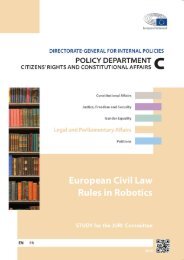Defining and managing reputation risk
Tjqga
Tjqga
Create successful ePaper yourself
Turn your PDF publications into a flip-book with our unique Google optimized e-Paper software.
Introduction<br />
The objective of the guide is to enable <strong>risk</strong> managers to lead<br />
an organisation’s approach to <strong>reputation</strong>al <strong>risk</strong> management.<br />
The guidance sets out a framework for breaking down the<br />
elements of an organisation that govern its <strong>reputation</strong>. Risk<br />
managers can use this framework to identify the possible<br />
<strong>risk</strong> events that affect each of these dimensions, <strong>and</strong> the<br />
stakeholders that are subsequently affected. This will allow for<br />
a structured approach to <strong>managing</strong> <strong>reputation</strong>al <strong>risk</strong>.<br />
Reputation <strong>risk</strong> is an ongoing yet growing concern for companies.<br />
Airmic members report <strong>reputation</strong>al <strong>risk</strong> as both their number<br />
one ‘keep’s me awake at night issue’ <strong>and</strong> a high concern for their<br />
executive management <strong>and</strong> Board. This is no surprise in today’s<br />
world where social media has made it possible for news to travel<br />
around the world within minutes <strong>and</strong> the perception of who you<br />
are as a company has a direct impact on several factors, including<br />
sales, stock price <strong>and</strong> licence to operate. High-profile incidents<br />
such as BP’s Deepwater Horizon oil spill disaster in 2010 alert<br />
companies that a <strong>reputation</strong>al problem can cause short-term issues<br />
to develop into long-term impacts including reduced profits, loss<br />
of customers <strong>and</strong> key employees, <strong>and</strong> eventually a slump in share<br />
price.<br />
Despite this concern, only a third of Airmic members have a high degree<br />
of confidence in how their firms manage <strong>reputation</strong>al <strong>risk</strong> <strong>and</strong> just 3% of<br />
members currently purchase insurance cover for <strong>reputation</strong>al exposures.<br />
Airmic members specifically report that they face hurdles in determining<br />
how to define <strong>and</strong> value <strong>reputation</strong>al <strong>risk</strong>. However, with pressure<br />
from above three-quarters of members plan to develop an approach<br />
to <strong>reputation</strong>al <strong>risk</strong> management in the next 12 to 18 months. Kasper<br />
Nielsen, Executive Partner at Reputation Institute, can underst<strong>and</strong> the<br />
difficulty: “Reputation is the perception others have of you. It’s a feeling,<br />
which makes it intangible. And <strong>managing</strong> something which is hard<br />
to define is difficult. To underst<strong>and</strong> <strong>reputation</strong> you need to make the<br />
intangible tangible. You need to break down your <strong>reputation</strong> into specific<br />
components that you can measure <strong>and</strong> manage. Then you are able to<br />
identify the specific impact from a crisis or an issue on your <strong>reputation</strong><br />
<strong>and</strong> manage it.”<br />
The goal is clear–to outline a systematic process for identifying,<br />
evaluating <strong>and</strong> mitigating <strong>reputation</strong> <strong>risk</strong>. Airmic engaged with<br />
Reputation Institute, whose RepTrak® framework identifies the seven<br />
‘<strong>reputation</strong> dimensions’, which govern how stakeholders perceive an<br />
organisation.<br />
This guide describes this framework <strong>and</strong> maps out a simple <strong>and</strong><br />
structured approach for using it to manage <strong>reputation</strong>al <strong>risk</strong>. In addition,<br />
the guide considers that although the current market for dedicated<br />
<strong>reputation</strong>al products is limited, the individual events that can dent an<br />
organisation’s <strong>reputation</strong> often are insurable. This can place <strong>risk</strong> <strong>and</strong><br />
insurance managers in a better position for leading the organisation’s<br />
response to <strong>reputation</strong>al <strong>risk</strong>. Appendices at the end of guide provide<br />
example matrices which can be used to identify the possible events <strong>and</strong><br />
the key stakeholders that determine an organisation’s <strong>reputation</strong>.<br />
4<br />
Airmic Technical



